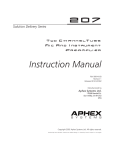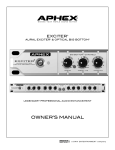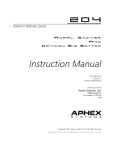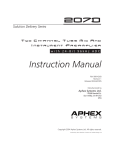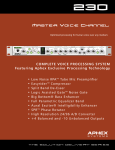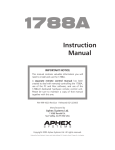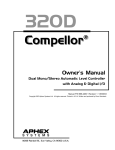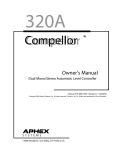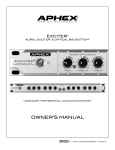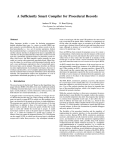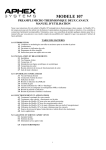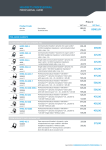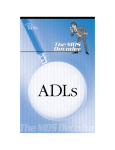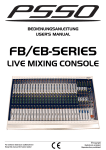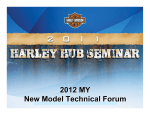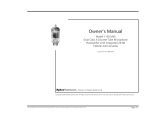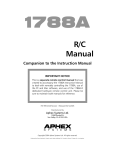Download 240 Owner`s Manual
Transcript
Solution Delivery Series 240 dual logic-gated EasyRider compressor Instruction Manual P/N 999-4400 Revision 2 Released 03/04/2006 Manufactured by Aphex Systems Ltd. 11068 Randall St. Sun Valley, CA 91352 USA S Y S T E M S Copyright 2006 Aphex Systems Ltd. All rights reserved. Produced by: Donn Werrbach. Creation tool: Adobe InDesign 2.0. Printed by: Stuart F. Cooper Co., Los Angeles. 240 instruction Manual A MESSAGE FROM THE PRESIDENT Dear Aphex Customer, Congratulations on your purchase of the Model 240 Dual Logic-Gated Compressor. We have combined two of our patented technologies- the Logic Assisted Gate™ and the Easyrider® Compressor- in an innovative, interactive way. In an era of endless choices of low cost outboard processors, processors built into mixing desks and software plug-ins that all leave something to be desired, we decided to introduce a product that cannot be duplicated in function or performance at any price. In addition to the exclusive processing technologies, we decided to bring these technologies together in an attractive, easy to use package. And we decided to bring it to market at a very attractive price. As with all our products, we are extremely proud of the ingenuity of design and the manufacturing quality of the Model 240. We love to hear from you, our customers, about your experiences with any of our products. Our customer support is unmatched in the industry, so please do not hesitate to contact us. Very Truly Yours, Marvin Caesar Safety Declarations CAUTION: For protection against electric shock, do not remove the cover. No user serviceable parts inside. WARNING: This equipment has been tested and found to comply with the limits for a Class A digital device pursuant to Part 15 of the FCC Rules. These limits are designed to provide reasonable protection against harmful interference when the equipment is operated in a commercial environment. This equipment generates, uses, and can radiate radio frequency energy and, if not installed and used in accordance with the operating guide, may cause interference to radio communications. Operation of this equipment in a residential area is likely to cause interference in which case the user will be required to correct the interference at his own expense. The user is cautioned that changes and modifications made to the equipment without approval of the manufacturer could void the user’s authority to operate this equipment. It is suggested that the user use only shielded and grounded cables to ensure compliance with FCC Rules. | Page 2 Aphex Systems Ltd. Model 240 Copyright 2006 by Aphex Systems, LTD. All rights reserved. All Aphex products are trademarks or registered trademarks of Aphex Systems, LTD. Other brand and product names are trademarks or registered trademarks of their respective holders. dual logic-gated easyrider™ compressor Table of Contents 1.0 Controls and Indicators with Quick Setup —— 4 2.0 Installation & Interfacing —— 6 2.1 RACK INSTALLATION —— 6 2.2 AC LINE CONNECTION —— 6 2.3 LINE INPUT CONNECTIONS —— 6 2.4 LINE OUTPUT CONNECTORS —— 6 2.5 LEVEL SWITCH —— 6 2.6 KEY INSERT JACK —— 6 2.7 POWER SUPPLY —— 7 3.0 Using the 240 —— 8 3.1 LEARNING THE LOGIC ASSISTED GATE —— 8 3.1.1 The Easiest Gate —— 8 3.1.2 Logic Assistance —— 8 3.1.3 Brief Gate Tutorial —— 8 3.2 USING THE GATED EASYRIDER COMPRESSOR —— 8 3.2.1 Automatic Adjustment —— 8 3.2.2 Limits of Conventional Compression —— 9 3.2.3 Overcoming the Limitations —— 9 3.2.4 About Our Gated Compression —— 9 3.2.5 Brief Compressor Tutorial —— 9 3.3 COMBINING GATING AND COMPRESSION —— 9 3.4 STEREO LINKING —— 10 4.0 Warranty & Service —— 11 4.1 Limited Warranty —— 11 4.2 SERVICE INFORMATION —— 11 5.0 Specifications —— 12 5.1 GENERAL SPECIFICATIONS —— 12 5.2 ARCHITECTURAL SPECIFICATIONS —— 13 6.0 Appendices —— 14 Appendix A: Balanced and Unbalanced Lines and Operating Levels Appendix B: Dealing With Grounds and Hum —— 15 Appendix C: Proper Wiring Techniques —— 17 Appendix D: Standard Cable Wiring —— 18 Appendix F: Helpful Wiring Table —— 22 Patent Notice —— Aphex Systems Ltd. Model 240 —— 14 24 Page 3 240 instruction Manual 1.0 Controls and Indicators with Quick Setup LOGIC ASSISTED GATE™ (Patent #5,334,947) The Model 240 features the award-winning Aphex Logic-Assisted Gate technology that has been so widely acclaimed since its first introduction with the Aphex Model 612 Expander/Gate. It never hesitates or chatters. Once triggered, even by a microscopic transient, it progresses fully through the attack, hold, and release sequence. All parameters are fully adjustable to let you optimize the gating effect. Threshold Range: -60 to +20dB. Adjust to reliably open the gate (let sound through) but reject unwanted background noise. The Gate can be effectively turned off by turning the threshold all the way to -60dB. Attack Range: 4uS to 100mS. Set to the fastest setting that does not cause a noticeable click when the gate opens. Slower settings may be useful for effects. Hold Range: 5mS to 500mS. Balance HOLD with RELEASE to obtain the best gating effect. Usually a longer hold time allows you to use a shorter release time. This can help when gating repetitive sounds like drums. The gate can be held long enough to transition the beats, and then a faster release can gate out the rumble and noise more effectively. The HOLD setting should always be at least equal to the ATTACK setting to insure the logic properly assists the attack function. Release Range: 100mS to 1S. Causes the gate to close (stop audio) very abruptly to very softly. This should be set to bring the best gating effect to the kind of sound you have. POWER INDICATOR Logo glows green indicating power is on. POWER SWITCH Turns power on and off. Page 4 YELLOW LED Glows when signal is below threshold (gatiing). THRESHOLD Determines the signal level that will cause the gate to open or close. ATTACK Determines the rate at which the gate opens (lets signals through) after attenuation. Depth Range: 2 to 80dB. Sets the maximum amount of gain reduction the gate will generate. At 80dB, the gate is virtually a switch. The audio will gate completely off. Less depth will allow the gate to reduce the signal but not necessarily cut it off. The best setting is one that reduces the unwanted noises just enough to be useful. Deep gating can sometimes be apparently extreme, making the sound seem chopped, especially with high background noise levels when the track is naked. Gated tracks added to a mix will have their gating effects masked by other tracks, allowing deeper gating to be used in many cases. EASYRIDER COMPRESSOR™ (Patent #5,483, 600) Further distinguishing the Model 240 is the award-winning Easyrider Compressor that adapts to the complex waveforms of audio signals to optimize loudness, consistency, and density of sound streams without creating unwanted side effects such as pumping or hole punching. With the simplicity of just two controls, Drive and Release, you can get fat and punchy compression or smooth and natural gain riding and anything in-between. Drive The Easyrider Compressor has a fixed internal threshold, so getting more or less compression means driving it with more or less level. The Drive control adjusts the signal gain ahead of the compressor to accomplish that. It does not affect the Gate Threshold. Speed The Easyrider Compressor has a complex set of time constants that adapt to the sound wave characteristics. The basal time constant can be set by the user with the Speed control. This can be looked at like the release time control on other compressor/limiters. With faster speed (shorter release time) the audio will be more aggres- HOLD Determines how long the gate stays open before it is allowed to close (release). RELEASE Determines the rate at which the gate closes (attenuates or cuts off the sound). DEPTH Sets the limit of how deep the gate will attenuate the signal when closed. OFF/ON Serves to bypass channel 1 or 2 independently unless the Compression Link switch is in. When linked, either IN/OUT switch operates both channels. DRIVE Sets the signal level that drives the compressor. More Drive gives more compression. SPEED Sets the baseline release rate of the compressor. LINK Causes the dual channels to become a stereo pair, forcing both channels to track compression and gating. OUTPUT Controls the final processed output level. Aphex Systems Ltd. Model 240 dual logic-gated easyrider™ compressor sively compressed and you will hear the sound becoming busier and fatter. Regardless of the Speed setting, the automatic time constants are working, just faster or slower. FEATURE: COMPRESSION GATE Many other products combine a compressor and gate, but there are problems making them work together. Usually, you have to just use one function. That’s because the compressor’s release occurs during the gate’s closure. The gate is trying to reduce the signal level while the compressor is trying to raise it. The compressor’s gain release counter-effects (fights against) the gate. The Model 240 features a new design first introduced in the Aphex Model 230 Master Voice Channel. The Easyrider Compressor is gain locked whenever the Logic-Assisted Gate activates. This holds the compression gain constant until the gate again opens, when compression is instantly returned to active duty and continues seamlessly. Gating and Compression happily work together for the first time in history! Even if the GATE DEPTH is set for zero, the compression gate will operate as indicated by the threshold LED. REAR KEY INSERT JACK Allows you to insert any kind of line level audio equipment into the signal path of the gate’s threshold detector. Common uses are the insertion of an equalizer to tune the detector to specific sounds or to inject an external Keying signal to open the gate in sync with another track. The operating level at this jack is in the vicinity of 0dBu. You should set up your inserted outboard gear accordingly. METER Dual two-color bargraphs indicate both compression and gating for both channels. Compression is shown as a green down-going bar while gating drives a red dot downwards. When the red dot is engulfed in the green bar, it turns yellow for better contrast. OUTPUT CONTROL Once all processing is set where you want it, the output can be adjusted to the perfect level as indicated by the input meters of the following equipment. Channel 2 controls are the same as Channel 1. Aphex Systems Ltd. Model 240 METERS Channels 1 and 2 each have a tri-color bargraph to display gain reduction caused both by compression and gating. Comnpression is indicated by a downward-moving red bar. Gating is indicated by a downward moving dot that appears yellow while nested within the red bar, and green when outside of the red bar. Gating and compression have separate scales. Page 5 240 instruction Manual 2.0 Installation & Interfacing 2.1 RACK INSTALLATION The Model 240 occupies a single rack space (45mm or 1-3/4 inches) of a standard EIA equipment rack. When rack mounting, use appropriate cushioned rack screws. Never restrict air flow through the device’s vents. When installing the units into a rack, distribute the units evenly. Otherwise, hazardous conditions may be created by an uneven weight distribution. Connect the unit only to a properly rated supply circuit. Reliable earthing (grounding) of rack mounted equipment should be maintained. Try not to position the 240 directly above devices that generate excessive heat such as power amplifiers (unless adequately ventilated) or near equipment with heavy transformer hum fields. Figure 2-1. Rrar Panel View 2.2 AC LINE CONNECTION Use only a power cord that carries approvals for use in your location. The 240’s internal power supply is designed to operate from all nominal power sources from 100 to 240 volts a.c. at 50/60Hz without requiring the user to change any settings. In case of failure, do not attempt to change the internal fuse because it will never blow unless the power supply fails catastrophically. The power supply will need to be serviced by a competent service technician in such a case. to feed separate equipment. The outputs can be used unbalanced. If you intend to make an unbalanced output from the XLR jack, simply take “hot” from pin 2 and use pin 1 for ground. Leave pin 3 unconnected. Unbalancing the TRS jack simply requires taking the “tip” as hot, and sleeve as ground. If you ground the sleeve, you will also be grounding pin 2 of the XLR which will make it operate as an unbalanced output. 2.3 LINE INPUT CONNECTIONS The audio line input connectors are located on the rear panel. Both standard XLR-3F and 1/4” TRS types are provided. The TRS jack is paralleled with the XLR, so they load each other and shorting one brings down the other. Do not plug two different sources into the two jacks at the same time. Refer to Appendix C & D for more information on the proper wiring of balanced and unbalanced lines. 2.4 LINE OUTPUT CONNECTORS There are two impedance balanced output connectors located on the rear panel: one 1/4” TRS phone type and one XLR-3M type. They are driven from the same output circuit but can be used at the same time 2.5 LEVEL SWITCH The Model 240 is designed to operate at either professional (+4dBu) or semi-pro (-10dBV) levels. Each channel has its own level selector switch on the rear panel. If not enough compression drive can be attained using the +4dBu setting, then switch it to -10dBV. 2.6 KEY INSERT JACK The signal that is sent to the gate’s threshold detec- Figure 2-2. Key Insert Adapter Cable For The Model 240 Mono (TS) Phone Plug From Equipment Output Ground Shield This End Only Tip To TRS Key Insert Jack Ring To Equipment Input Mono (TS) Phone Plug Page 6 Sleeve Ground Shield This End Only Aphex Systems Ltd. Model 240 dual logic-gated easyrider™ compressor tor passes through the Key Insert Jack so you may insert an equalizer or external key source. With no plug inserted, the jack’s switches normal the signal through. With a plug inserted, the path is broken and must be completed through an external unbalanced path. See Figure 2-2 for an example of a proper breakout adapter cable. 2.7 POWER SUPPLY The 240 is internally powered from a standard IEC power receptacle on the rear panel. Be sure you use a power cord that is approved for use in your jurisdiction. ACCEPTABLE POWER RANGE 85 to 265V~, 50 to 60Hz Soft-start, overload foldback limiting, and accross-theline voltage spike protection is incorporated to protect the power supply from damage that might be caused by component failure or power line disturbances. If the internal fuse blows out, a catastrophic failure has occurred and simply replacing the fuse will not fix the problem. Due to the extensive protective measures used, it is highly unlikely a catastrophic power supply failure will ever occur. However, if it does, you should contact the factory or a competent service technician to affect repairs. There are no user serviceable parts inside. Aphex Systems Ltd. Model 240 Page 7 240 instruction Manual 3.0 Using the 240 Figure 3-1. Front Panel View 3.1 LEARNING THE LOGIC ASSISTED GATE 3.1.1 The Easiest Gate Books aren’t much help in learning how to use a Noise Gate effectively. Only direct experimentation with audio sources can bring you to any point of proficiency. Luckily, the Logic Assisted Gate of the Model 240 is by far the easiest full featured gate to master and use well. 3.1.2 Logic Assistance What makes the Logic Assisted gate different is the digital logic that is used to absolutely guarantee the gate opens, holds, and releases exactly the same way, as set by the controls, every time. Standard Noise Gates operate on the principle that the audio wave itself not only triggers the gate, but the power in the wave is used to force open the gate and hold it open. When the wave is low in power, such as a transient drumbeat, or a spoken voice, the gate may open too late, not fully open, chatter, or perhaps not even open at all. With Aphex’s Logic Assisted Gate, these things can’t happen. If the threshold is reached, even by the shortest transient, the logic system takes over and operates the gate without depending on the power of the sound wave. Logic will cause the full attack, hold, and release to occur as determined by the front panel adjustments. Even with a very slow attack setting, a short transient like the leading edge of a snare tap will bring the gate open fully. This translates to extremely consistent gating with a threshold setting that is far less critical. The full range of expression can be gated successfully whereas with a standard Noise Gate, it’s almost impossible to find a reliable threshold setting that won’t miss some of the beats or misfire on crosstalk. IMPORTANT NOTE To insure the logic function, the HOLD time should always be set to a value at least equal to the ATTACK time. Page 8 3.1.3 Brief Gate Tutorial Here is a basic procedure for getting the benefits of the Logic Assisted Gate. Of course, different sources like voices, drums and guitars need different settings. This example uses a recorded or live drum track: 1. Set Threshold, and Depth full CCW 2. Set Attack, Hold and Release full CCW. 3. Start the drum track. You won’t hear it yet because the gate threshold is too high. 4. Begin turning the Threshold CCW until drum beats start popping the Gate open. At first only the hardest beats will pop through. Find the point where you can get all the desired weaker beats. 5. Increase the Hold time until drums don’t quench between pattern beats. 6. Increase the Release time to make the drum trails sound more natural, but still quenched enough to quiet the in-between noises and crosstalk from other drums. 7. Slow up the attack time just to see how it affects the drum attack. Find the setting you like most. 8. Reduce the Depth to the point where you get enough noise attenuation but not necessarily a deep dark sonic abyss (unless it’s what you want). That’s about it. Most users will get the nack within a few minutes. You will probably discover numerous gating effects that you like while experimenting. One thing the Logic Assisted Gate can do that no other Gate can is to attack very slowly while still triggering positively every time. Try really slowing the attack down and hear the almost “backwards drum” effect it produces. 3.2 USING THE GATED EASYRIDER COMPRESSOR 3.2.1 Automatic Adjustment The Easyrider Compressor takes into account what other compressors don’t: the audio wave’s complex energy level. It makes using compression exceptionally easy by making adjustments automatically. Aphex Systems Ltd. Model 240 dual logic-gated easyrider™ compressor 3.2.2 Limits of Conventional Compression Audio sources vary considerably in their peak and average power levels. For example, when sounds are already compressed and dense, their peaks are suppressed and the average energy level is relatively high. Uncompressed, natural sounds have much less average energy compared to their peak level. Each sound has its own peak to average ratio and wave envelope shape. That’s why no particular attack and release settings of a conventional compressor can work well on everything. You always have to fiddle with a regular compressor’s settings to get a good sound, and still it may not ever be quite right. That’s because it can’t follow and adjust itself for the varying audio characteristics. 3.2.3 Overcoming the Limitations The Easyrider Compressor constantly changes its attack and release characteristics to adapt to varying audio waveforms. It can hold up a consistent punch and density over a whole mix of sounds, but it can handle the expression and density of a single instrument or vocal track equally well. You can use it to ride gain smoothly over an audio track, or to bring all the elements closer together in loudness and density without ever getting the “sucked out” effect of regular compression. Figure 3-2. Jumper Locations (one per channel) again starts, it is already sitting at the right gain reduction and just continues tracking along seamlessly. You don’t get the front-edge breath exaggeration or “chiff” of typical compressors. If, or any reason, you decide you don’t want compression gating to take place, you can disable the feature by moving internal jumpers (one per channel). 3.2.5 Brief Compressor Tutorial One of the advantages of the Easyrider Compressor is its ultimate simplicity with only two controls to adjust. Here’s an example of how to set it up successfully. 3.2.4 About Our Gated Compression It would be a disadvantage if the Logic Assisted Gate were to start attenuating the noise as it should, while the compressor gain-releases bringing the noise right back up at the same time. This is what happens in other compressor/gate products. It greatly limits their usability in combination. The Model 240 fixes that problem by gating the gain reduction of the compressor while the gate is acting. In other words, the compression is stopped and cannot release while the gate is closed or closing. 1. Start audio through the Model 240 2. Set the Gate “off” by setting its threshold full CCW. 3. Adjust the Drive control to get something like 6dB of compression 4. Adjust the Speed control from slow to fast to locate a sweet spot for the particular sound track. 5. Readjust the Drive to obtain enough compression to ride the gain or get the density you need. This may be as little as 3-4dB of compression or as much as 20dB. This provides perfect cooperation between the gate and compressor at all times. It also has the added advantage of smoothing out the compression during sound pauses. Instead of having to attack all the way back into full gain reduction whenever the sound That’s it! It’s just that simple. Aphex Systems Ltd. Model 240 3.3 COMBINING GATING AND COMPRESSION Using the Logic Assisted Gate and the Easyrider Compressor is easy. As described above, they are very Page 9 240 instruction Manual Using the 240 cooperative. Simply adjust the gate first followed by the compressor - in the order they appear on the front panel. 3.4 STEREO LINKING The Model 240 is a dual channel device that can be stereo linked. Normally, only the compressors are stereo linked by pressing the Compression Link button. This links the baseline compression together, but still allows independent compression activity for transient control. The advantage of that is maintaining perfect stereo balance but avoiding cross-channel ducking on single-channel transients. The sound remains much more natural. Gating is left independent in order to facilitate the best possible noise reduction. When Stereo Linked, the two IN/OUT switches become interconnected so either one will send both channels out of bypass. Page 10 Aphex Systems Ltd. Model 240 dual logic-gated easyrider™ compressor 4.0 Warranty & Service 4.1 Limited Warranty PERIOD One year from date of purchase SCOPE All defects in workmanship and materials. The following are not covered: a. Voltage conversions b. Units on which the serial number has been defaced, modified, or removed c. Damage or deterioration: 1. Resulting from installation and/or removal of the unit. 2. Resulting from accident, misuse, abuse, neglect, unauthorized product modification or failure to follow instructions contained in the User’s Manual. 3. Resulting from repair or attempted repair by anyone not authorized by Aphex Systems. 4. Occurring from shipping (claims must be presented to shipper). WHO IS PROTECTED This warranty will be enforceable by the original purchaser and by any subsequent owner(s) during the warranty period, so long as a copy of the original Bill of Sale is submitted whenever warranty service is required. WHAT WE WILL PAY FOR We will pay for all labor and material expenses for covered items. We will pay return shipping charges if the repairs are covered by the warranty. LIMITATION OF WARRANTY No warranty is made, either expressed or implied, as to the merchantability and fitness for any particular purpose. Any and all warranties are limited to the duration of the warranty stated above. EXCLUSION OF CERTAIN DAMAGES Aphex Systems’ liability for any defective unit is limited to the repair or replacement of said unit, at our option, and shall not include damages of any other kind, whether incidental, consequential, or otherwise. Some States do not allow limitations on how long an implied warranty lasts and/or do not allow the exclusion or limitation of incidental or consequential damages, so the above limitations and exclusions may not apply to you. This warranty gives you specific legal rights, and you may also have other rights which vary from State to State. 4.2 SERVICE INFORMATION If it becomes necessary to return this unit for repair, you must first contact Aphex Systems, Ltd. for a Return Authorization (RMA number), which will need to be included with your shipment for proper identification. If available, repack this unit in its original carton and packing material. Otherwise, pack the equipment in a strong carton containing at least 2 inches of padding on all sides. Be sure the unit cannot shift around inside the carton. Include a letter explaining the symptoms and/or defect(s). Be sure to reference the RMA number in your letter and mark the RMA number on the outside of the carton. If you believe the problem should be covered under the terms of the warranty, you must also include proof of purchase. Insure your shipment and send it to: Aphex Systems, Ltd. 11068 Randall Street Sun Valley, CA. 91352 PH: (818) 767-2929 FAX: (818) 767 -2641 Aphex Systems Ltd. Model 240 Page 11 240 instruction Manual 5.1 GENERAL SPECIFICATIONS 5.0 Specifications LINE INPUTS Connector: Type: Input Z: Maximum Input Level (MIL): CMRR: Nominal Gain: Operating Level: XLR-3F & 1/4 in. TRS phone Jack each channel Balanced, may be used unbalanced 10KΩ nominal +24dBu Greater than 70dB @ 60Hz 0dB Switched between -10dBV and +4dBu; channels independent OUTPUT Connector: Type: Output Z Balanced: Output Z Unbalanced: Nominal Level Maximum Output Level (MOL): XLR-3M and TRS 1/4 in. phone jack XLR is Impedance Balanced (may be used unbalanced); TRS is unbalanced. XLR & TRS: 66Ω XLR & TRS: 33Ω Same as input, determined by operating level switch +25dBu Unloaded COMPRESSOR Attack/Release: Ratio: Threshold: Knee: Program dependent, user variable release baseline. 3:1 Fixed Medium Hard GATE Attack: Hold Release: Threshold: Depth: Variable, 4 uSec to 100 mSec Variable, 5 mSec to 500 mSec Variable, 100mSec to 1Sec Variable, +20 to -60dB Variable, 0 to 80dB GATE INSERT Connector Type Send: Connector Type Return: Nominal Operating Level: Point of Insertion: 1/4” TRS Phone Jack, Balanced 1/4” TRS Phone Jack, Balanced 0dBu Between input stage and gate detector ANALOG AUDIO THD: IMD: Freq Resp (FLAT): OTHER SPECS Power requirements: Power Consumption (maximum): Dimensions: Depth Behind Front Panel: Net Weight: Shipping Weight: <.01% @ +4dBu Out <.01% @ +4dBu Out 5Hz to 65KHz +/- 1dB 85 to 260V~, 50-60Hz 12 Watts 19” W x 1.75” H x 8.25” overall depth (482.6mm W x 445mm H x 209.6mm overall depth) 7.5” (190.5mm) Rack-mounted: 6lbs. (2.73kg) 9lbs. (4.1kg) All specifications are subject to change without notice. Page 12 Aphex Systems Ltd. Model 240 dual logic-gated easyrider™ compressor 5.2 ARCHITECTURAL SPECIFICATIONS Basic Description A two-channel linkable dynamics processor comprising a noise gate and a compressor for each channel. The compression of the two channels shall be linkable for stereo operation. The gate and compression elements shall be cooperative when the gate is cutting down the channel gain, such that any compression gain reduction that was present when the gate started attacking will be locked steady so as not to counter-effect the gate. The Noise Gate shall comprise a logic operated process whereby any threshold detect, regardless of transience or weakness above threshold, causes the full attack and hold sequence to complete. The threshold detecting circuit shall have a rear panel insert jack to allow insertion of outboard processor devices between the trigger source and the threshold detector. The Compressor shall comprise an adaptive dynamic range compressor with multiple time constants that can adjust to varying audio waveforms to provide optimized compression. Physical Properties The device shall be packaged in an all metal chassis measuring 19” (482.23mm) wide, 1.75” (44.42mm) high, with an overall depth of 8.25” (210mm). Depth behind the front panel shall be approximately 7” (178mm). The device shall have a net weight of approximately 6lbs. (2.73kg) and is capable of mounting in a standard electronic equipment rack. Power The unit shall have a self contained power supply operating from the ac line. Primary voltage, connectorization and agency listings shall be appropriate to meet local requirements. Aphex Systems Ltd. Model 240 Page 13 240 instruction Manual 6.0 Appendices Appendix A: Balanced and Unbalanced Lines and Operating Levels Interfacing all types of equipment with balanced and unbalanced lines and can sometimes be troublesome. First you have to somehow connect balanced to unbalanced and then you have to deal with different levels. This tutorial will teach you about the principles of balanced and unbalanced lines, wiring standards, and how to effectively interface them. Standards Professional audio equipment usually comes equipped with inputs and outputs that are balanced using 3-pin XLR connectors and sometimes 1/4 inch phone jacks as well. This equipment most often is designed to operate at +4dBu, a professional industry standard. That translates to a magnitude of 1.23 volts RMS (Root-Mean-Squared). wire is the source and which is the return alternates accordingly. In this regard, balanced and unbalanced lines are the same. They both need two conductors. What makes a system unbalanced is when one of the wires is formed into a tube that wraps around the other conductor, without touching it, such that the outer conductor can be said to “shield” the inner conductor. This describes all of the coaxial cable used for video, cable-TV and radio as well as most of the high fidelity audio cables. Figure 1 Balanced Line Model Consumer gear has unbalanced I/O as standard, usually on RCA jacks. The normal operating signal level follows the IHF (Institute of High Fidelity) standard of -10dBV, or 0.316 volts (316mV) RMS. Converting to dBu dimensions, this works out to be the same as -7.79dBu. There is therefore a difference of 11.79dB between pro and consumer operating levels. Grounding There is the notion that some king of earthly “ground” exists out there that sinks all the noise and acts as some kind of a shield. You see wires connected to ground rods and water pipes that are supposed to get a good ground. This is not a correct interpretation of grounding from an audio standpoint. Proper grounding of equipment and wiring is important and you will gain a better understanding of that as you read along. Balanced -vs- Unbalanced Every audio signal is connected through a circuit. The circuit must contain two conductors to create a complete return path. In other words, a signal voltage is conducted to a piece of equipment by injecting a current into a wire. That current has flow though to the destination through the wire and return back to the source through another wire. Since audio is an alternating voltage, swinging through negative and positive polarity, the current through the two conductors changes direction each alternate half cycle. Which Page 14 Figure 2 Unbalanced Line Model Balancing If both conductors are identical insulated wires that are twisted together, then they form a balanced line. This describes telephone lines, microphone cables, and most professional audio cables. Typical balanced cables include an additional shield wrap around the twisted pair, but this is not strictly required for balanced lines to work properly. Many people, because they have more experience with unbalanced wiring, think that balanced is confusing. Believe it or not, balanced lines are really easier to understand than unbalanced. There is no grounding issue with balanced, and the way it works is perfectly natural and simple. Balancing naturally rejects hum and noise and eliminates all sorts of complications in interfacing. Balanced transmission works something like this. Aphex Systems Ltd. Model 240 dual logic-gated easyrider™ compressor Your balanced input stage looks at the two wires and detects only the potential (voltage) difference between them. Anything that is the same on the two wires (for all practical purposes as seen measuring from ground) is called a common mode signal and is cancelled out by the differential amplifier. Figure 1 illustrates how the hum is induced into both wires equally and therefore is cancelled out. Since the balanced line has wires that are twisted together, each wire tends to pick up the same amount of induction from external sources. Induction will create no significant voltage difference between the wires, hence the noise (or hum) will not be picked up by the differential input stage. i.e., there is no “grounding difference” that can cause current to flow through the shield conductor. Grounding difference is a serious problem in studios, because often the equipment grounds are connected to power outlet grounds, and there can be a significant difference of ac voltage between alternating wall outlet grounds. For this reason, unbalanced systems can sometimes never be made hum free, and just changing one piece of equipment in a studio can cause hum to appear somewhere else. When you are using unbalanced gear, it is a very good procedure to power all your equipment from one large power isolation transformer. At the very least, make sure all equipment is powered together off the same distribution panel circuit (same circuit breaker). It can be seen that the signal generator driving the twisted pair will cause a difference between the wires, and that signal will be readily picked up by the differential input stage. One of the beauties of the balanced line is that it is completely independent from ground. Nothing is connected to ground at all, nor does it care about ground. Nevertheless, most professional cable has an overall shield wrap that is intended to be connected somehow to ground. You may well ask why, and the answer is less than glorious. Simply, nothing is perfect, not even balanced cable. Under some circumstances the shield can overcome extreme interference problems that can’t be adequately rejected by the twisted pair alone. Things like 2-way radios, television transmitters, and light dimmers can induce very heavy interference that may be reduced by shielding. You are going to find virtually all balanced cables include a shield so you need to deal with it, even if it is not actually needed. That subject will be addressed a little later. Appendix B: Dealing With Grounds and Hum Unbalancing Unbalanced wiring works a little differently. Figure 2 shows the basic plan. In this case, the wires are not twisted, they are coaxial. The unbalanced input stage is somewhat like the balanced input stage because amplifies a difference signal, but this time it is the difference between two non-symmetrical conductors. To make things even less symmetrical, the outer conductor is connected to ground at both ends. The principle is that the outer shield conductor shields the inner conductor from induced noises. This can only work well if the cable is relatively short and the ground at each end of the cable is somewhat equal, A ground loop is an ac current that has become routed through your audio ground system. The current comes mainly from ground potential differences that exist between different wall outlets that return to opposite phases at the power distribution panel. Secondarily, however, many pieces of equipment contain line filters and transformers that leak a small amount of ac power into the chassis and ground return. Aphex Systems Ltd. Model 240 Ground Loops Many people equate this term with hum, and that’s just about the bottom line of it. If you have a ground sensitive system, like unbalanced audio equipment for example, then hum will result from ground currents that flow from the ac power system. It is sometimes very difficult to isolate and stop ground currents between unbalanced equipment, but it is quite easy to clean up balanced gear. That’s why pro gear is always balanced! The cost of balancing is that of more expensive connectors, cable, and electronics but the cost is worth it when you depend on your audio quality. That’s why the Model 240 is equipped with a fully balanced I/O. Now that we’ve sold you on only using really expensive pro gear, lets show you how to get away with the really cheap stuff! At least from the standpoint of killing ground hum. You may once have had the experience of getting zapped by touching two pieces of gear at the same time. That illustrated the ground loop effect going Page 15 240 instruction Manual 6.0 Appendices straight through you! No matter what you do, you may not be able to prevent some of your equipment from generating ground currents. The most likely culprits are digital products because they use switching power supplies that require heavy line filters to prevent conducted EMI from going out of the box. These line filters often take the ground leakage current right up to the UL safety limits. Although it probably won’t kill you, that is a lot of ground loop current for audio cables to handle. There are basically three ways to attack the problem of a ground loop. First is to eliminate it from its source, and the second is to re-route it through another path. The third is to balance out your unbalanced audio interfaces. Identify the Sources A good way to identify grounding problems is to use a multimeter to check the ac voltage between the chassis of your various gear when no audio cables are hooked up and all gear is plugged in and switched on. Just start touching the two probes to the metal chassis of different pieces of gear. Ideally, you should always see zero volts. Warning! You may see as much as the whole line voltage between two different chassis! It does happen. This voltage between chassis will be responsible for your ground loop problems. If you find there is more than about 1 volt between equipment grounds, you should start looking for a remedy. Commonize the Power Try plugging all of your equipment into the same outlet strip. Get one that has enough outlets in one strip or string more than one together. Of course, you need to make sure you don’t overload the one ac circuit your strip is plugged into. If the load is too great for one circuit, use a second or third circuit that is tapped off the same 120 volt phase in your distribution panel. That means all outlets should be on odd or even numbered circuit breakers. That’s because, as you go down the column, the circuit breakers tap into alternating legs of your incoming electric power. Be sure you’re always on the same leg. You can tell you’re on the same leg by measuring the ac voltage between the hot slots of the different outlets you’ve chosen. It should be very low or zero. That will remedy 50 percent of the cases. For products that have 2-wire power cords, try reversing one of the power cords in the socket. That may reduce the ground current generated by the internal electronics of the offending gear. Redirect Ground Loops Sometimes it just comes down to brute force grounding. That means providing such heavy, low resistance, ground current paths that little current is left to flow through your audio grounds. You can try adding heavy gauge, for example 12 gauge, copper wire from chassis to chassis. You will need to locate a metal screw that solidly binds to the metal chassis of the gear. You may even need to drill a hole through the chassis and install a screw yourself. Equipment in rack shelves can have their chassis grounded to the metal rack frame by a heavy wire and the frame itself can act as a brute force ground. You just have to try everything you can think of. Usually a combination of all these methods will be needed to completely clean up a badly humming audio system. Balance Out the Audio Remember, balanced lines are inherently hum free. If you can balance out your unbalanced equipment, you will be able to stop the hum. Pseudo Balancing You will find in Appendix D an interconnecting method called Pseudo Balanced. This works when connecting an unbalanced output to a balanced input. This breaks up the ground loop by requiring the shield to be grounded only at one end. For best results always ground the shield only at the receiving end. Level Interface Units Aphex manufactures the Model 124A Level Interface box which is designed to electronically convert two unbalanced inputs and outputs into two balanced inputs and outputs, and at the same time translate the -10dBV IHF unbalanced levels to the pro +4dBu balanced levels. This cost effectively gives your nonprofessional unbalanced equipment a fully professional I/O equal to the world’s best pro audio gear. Seriously consider putting one of these on each unbalanced piece of gear you use. Check the Cord Polarity Page 16 Aphex Systems Ltd. Model 240 dual logic-gated easyrider™ compressor Avoid Transformers The use of balancing transformers is an option, but you will invariably lose audio quality due to transformer limitations. Try everything else first. Appendix C: Proper Wiring Techniques A true balanced line should be used wherever your equipment allows. Use “twisted pair” shielded cable. For unbalanced wiring you should use high grade, low capacitance shielded wire for best results. If you have an unbalanced output but have a balanced input, the “pseudo-balanced” configuration may help deal with ground loop hum. This method and others are illustrated in Table 2. CONNECTOR WIRING STANDARDS The 3 pin XLR, 1/4” (63.5 mm) TS mono phone and the 1/4” (63.5 mm) TRS stereo phone are the most commonly used line level connectors in pro audio. Less common is the use of the “RCA” phono jack, which is essentially a consumer type connector. The XLR and the TRS are three conductor and are used for balanced connections. The TS and the RCA are two conductor and are used for unbalanced connections. In addition to the three main contacts on an XLR there is also a grounding lug contact. This lug is connected to the connector’s case (shell). In all Aphex products audio ground and chassis ground are one and the same. Aphex products that use XLR connectors tie Pin I to the XLR case automatically. Therefore it is not necessary to use the XLR case-ground lug. This also makes possible the use of XLR ground drop adapters (see Note 3). TABLE 1: The wiring convention shown is now standardized in 17 countries including the USA. Please note that any equipment that still uses Pin 3 as positive on XLR connectors is not adhering to the standard. THE PIN 1 DILEMMA AND HOW IT AFFECTS CABLE SHIELD CONNECTIONS The three main contacts on an XLR (or TRS) and the accepted wiring assignments shown above are only part of the picture. The standard for terminat- Aphex Systems Ltd. Model 240 ing ground is Pin 1 (Sleeve). But which ground? It could be connected to audio signal ground or chassis ground depending on the method of grounding used by the equipment manufacturer. In all Aphex products audio ground and chassis ground are one and the same at all I/O jacks. This is just good, common sense engineering practice (which is what you would expect from us, course). Unfortunately, many products are designed so that the noisy currents from the shield drain into signal ground instead of chassis ground. This practice creates a real hum and noise problem for end-users. The appropriate overall grounding scheme of an audio system would be a lot easier to predict without this problem1. The standard balanced line wiring recommendation from Aphex Engineering is this: In the majority of cases maximum noise rejection occurs when the shield is connected to the input ground only (especially in locations with high levels of RFI). That means the sending end shield should be left disconnected. However, if you already have cables with the shield connected at both ends, go ahead and try them out. If you are connecting a fairly simple audio system it may be fine as is. A word on optional shield connections: Connecting the cable shield of a balanced line at both ends creates unnecessary ground loops which may carry noise and hum currents that can be amplified. Connecting the shield only at the sending end (instead of the receiving end) may exaggerate common mode noises at the receiving input stage. It can actually increase RFI and noise more than having no shield at all. Because of the “Pin I Dilemma” (mentioned above) you may be forced, in some situations, to experiment with how the cable shield is connected to ground to eliminate a pesky hum or radio interference problem. It might be good to try XLR ground drop adapters (see Note 3) as a method of trying these conflicting methods out and being able to change easily if necessary. IMPEDANCE Regardless of inaccuracies, it has become more or less standard over the years to refer to balanced lines as low impedance and unbalanced lines as high Page 17 240 instruction Manual Appendices TABLE 1 - BALANCED & UNBALANCED CONNECTOR WIRING STANDARDS 3-Pin XLR 1/4” TRS Phone Standard Wiring Convention (Balanced) Pin-1 Sleeve Ground/Shield (Earth, Screen) Pin-2 Tip Positive (Signal, High, Hot) Pin-3 Ring Negative (Signal Reference, Return, Low, Common) 1/4” TS Phone RCA Standard Wiring Convention (Unbalanced) Tip Center Pin Positive (Signal) Sleeve Shell Ground/Shield (Signal Reference/Return) impedance. The fact is, however, that both balanced and unbalanced lines are operated at low impedance in modern practice owing to the fact that all output stages have become low impedance. A few exceptions might be outputs from passive mixers, instrument pickups, electric guitars and some keyboard synthesizers. It is generally ideal to drive any audio line from a low impedance and receive into a high impedance. Generally, a minimum 1: 10 ratio is possible. This is called “bridging”. This has become modern practice and all balanced inputs are normally running 10K ohms or higher impedance. Because of these developments, it is now no longer as critical to consider impedance when dealing with interfacing pro line level equipment (impedance “matching” is mostly a requirement of the past). A word on impedance and interfacing adapters: If you are connecting between two line level devices and they have different connectors (example: 1/4” phone to XLR or vice-versa), you do not need to use an impedance matching transformer. With very few exceptions you are strictly dealing with a difference in connector types and should only use hard-wired adapters (or cables) for this situation. APPENDIX D: Standard Cable Wiring In relation to 1/4” phone jacks, you may see the terms “TS” and “TRS” as abbreviations. Here is a what that means: TS refers to the Tip-Sleeve or “mono” 2- Page 18 conductor type and TRS refers to Tip-Ring-Sleeve or “stereo” 3 conductor type 1/4” phone connectors. This applies to jacks (female connectors) and plugs (male connectors). Note: We recommend using only conventional 1/4” phone plugs with the Model 240 and with all other audio equipment. Professional patch bay cords using brass PJ055 telephone type plugs are designed only for patch bays and will not make proper contact with standard 1/4” phone jacks. The following instructions show all the different ways you will probably ever need to hook up your 240 as well as any other equipment you may own. You will see that connecting balanced outputs to balanced inputs is ultimately simple and the same cable will work for all flavors of output stages. Connecting a balanced output to an unbalanced input requires a little more knowledge and care. You should refer to your equipment manuals and determine the type of balanced output stage that is provided, then use the correct “transition cable” as depicted in this section. Improper transition cables can cause crosstalk, hum, and distortion problems within your system. TYPES OF BALANCED OUTPUTS Believe it or not, there are at least 5 types of balanced output stages in use today. They may be placed into two main classes: transformer balanced, and Aphex Systems Ltd. Model 240 dual logic-gated easyrider™ compressor transformerless balanced, usually called “active balanced”. Transformer balanced outputs are becoming outdated because of their high cost and their sonic limitations. However, they can still be found on a lot of older equipment. Within the transformerless class, there are several types of circuits that are used by different manufacturers. These different types of output circuits all look just about alike to any balanced line, but they act differently when driving an unbalanced line. You need to observe the proper cable wiring for each type of output circuit. We strongly recommend that you refer to your various equipment manuals to find out what is used in each case before hooking up to unbalanced lines. When connecting a balanced output to a balanced input, however, you don’t need to know what kind of balanced output you are dealing with. Simply treat it generically. XLR to XLR OK for Microphones Standard store-bought cable. Shield grounded at both ends. Positives: Good for microphones. Negatives: May cause ground loops through the shield grounds if used to connect equipment together. Preferred for Line Levels Shield grounded at receiving end only. Positives: Stops ground loops and reduces noise. Negatives: None PART 1: BALANCED OUT to BALANCED IN 1/4” TRS Phone to 1/4” TRS Phone Balanced Cables OK Standard store-bought cable. Shield is grounded at both ends. Positives: Both ends are interchangeable. Negatives: May cause ground loops through shield contacts. No Connect BETTER Custom cable. Shield is grounded at receiving end only. Positives: Stops ground loops and reduces noise. Negatives: Should be oriented so lifted shield is at sending end. XLR to 1/4” TRS Phone Balanced Cables From an Output To an Input Female XLR Male XLR To an Input From an Output Stereo Phone Plug Stereo Phone Plug No Connect Stops Ground Loops No Connect Stops Ground Loops Aphex Systems Ltd. Model 240 Page 19 240 instruction Manual Appendices PART 2: BALANCED OUT to UNBALANCED IN Voltage Balanced Outputs It was mentioned that there are several types of balanced output stages in use today. The following diagrams show you how to properly unbalance each type of output. If you follow these instructions, you should have no problems. SIMPLIFIED SCHEMATIC Unbalancing loses half the output level. You lose 6dB of gain. Female XLR Don’t Ground or Connect Pin 3 Transformer Balanced Outputs Mono Phone Plug SIMPLIFIED SCHEMATIC Unbalancing loses no output level. You retain full gain. Female XLR Ground Pin 3 Directly to Pin 1. Alternatively, Carry Pin 3 Through Twisted Pair Cable and Ground at Other End Impedance Balanced Outputs Mono Phone Plug SIMPLIFIED SCHEMATIC Unbalancing loses no output level. You retain full gain. Female XLR Servo Balanced Outputs Pin 3 Doesn’t Matter OK Grounded or Not Grounded Mono Phone Plug SIMPLIFIED SCHEMATIC Unbalancing loses no output level. You retain full gain. Female XLR Ground Pin 3 Directly to Pin 1 Do Not Carry Pin 3 Through Cable and Ground at Other End Mono Phone Plug Page 20 Aphex Systems Ltd. Model 240 dual logic-gated easyrider™ compressor PART 3: UNBALANCED to UNBALANCED Standard Cable (Guitar Cord) Mono (TS) Phone Plug Mono (TS) Phone Plug PART 4: UNBALANCED OUT to BALANCED IN Standard Method Enhanced Method (Pseudo Balanced) Advantage: Reduced Hum and Noise Pickup Mono (TS) Phone Plug Stereo (TRS) Phone Plug (Guitar cord of Part 3 above usualy works just as well) Mono (TS) Phone Plug Stereo (TRS) Phone Plug Not Used Male XLR Male XLR Mono (TS) Phone Plug Mono (TS) Phone Plug Not Used PART 5: “Y” INSERT CABLES (Some equipment reverses the role of tip and ring. Check your manuals.) Male XLR To Equipment Input Ground Shield This End Only Sleeve Female XLR Tip Ring Stereo Plug To TRS Insert Jack Ground Shield This End Only From Equipment Output Don’t Connect Pin 3 Mono (TS) Phone Plug To Equipment Input To TRS Insert Jack Ground Shield This End Only From Equipment Output Mono (TS) Phone Plug Aphex Systems Ltd. Model 240 Ground Shield This End Only Page 21 240 instruction Manual APPENDIX F: HELPFUL WIRING TABLE Also see next page.. TABLE 2 - - TYPES OF ACTIVE BALANCED INPUT/OUTPUT CIRCUITS & INTERFACE WIRING OUTPUT TYPE WIRING DIAGRAM (Interface from OUTPUT to INPUT) INPUT TYPE Resulting Interface METHOD / LEVEL Wire: single conductor with a shield (coax style) 1 POSITIVE (HIGH) Unbalanced SHIELD (GND) Unbalanced Wire: two conductor with a shield (twisted pair) 2 Unbalanced POSITIVE (HIGH) NEGATIVE (LOW) SHIELD (GND) Unbalanced Pseudo Balanced Balanced No Connection (see Note 4) (see Note 4 for Unbalanced wiring) Unity Gain2 Unity Gain2 Wire: two conductor with a shield (twisted pair) 3 Voltage Balanced POSITIVE (HIGH) NEGATIVE (LOW) SHIELD (GND) Unbalanced Unbalanced 6dB Loss2 Balanced Balanced Unity Gain2 Unbalanced Unbalanced Unity Gain2 Balanced Balanced Unity Gain2 Unbalanced Unbalanced Unity Gain2 Balanced Balanced Unity Gain2 No Connection (see Note 5) Wire: two conductor with a shield (twisted pair) 4 Voltage Balanced POSITIVE (HIGH) NEGATIVE (LOW) SHIELD (GND) NC Optional (see Note 6) Wire: two conductor with a shield (twisted pair) 5 Impedance Balanced POSITIVE (HIGH) NEGATIVE (LOW) SHIELD (GND) NC Optional (see Note 6) Wire: two conductor with a shield (twisted pair) 6 Impedance Balanced POSITIVE (HIGH) NEGATIVE (LOW) SHIELD (GND) NC Optional (see Note 6) 7 CrossCoupled Balanced (Aphex Servo Balanced) 8 CrossCoupled Balanced (Aphex Servo Balanced) Page 22 Wire: two conductor with a shield (twisted pair) POSITIVE (HIGH) NEGATIVE (LOW) SHIELD (GND) NC Optional (see Note 6) Wire: two conductor with a shield (twisted pair) POSITIVE (HIGH) NEGATIVE (LOW) SHIELD (GND) NC Optional (see Note 6) Aphex Systems Ltd. Model 240 dual logic-gated easyrider™ compressor NOTES The following notes are referenced in the text and in Table 2 on the preceding pages. Note 1: ADDITIONAL READING SUGGESTIONS: Sound System Engineering by Don Davis and Carolynn Davis (Howard W. Sams and Co.), Handbook for Sound Engineers (The New Audio Cyclopedia) Edited by Glen Ballou (Howard W. Sams and Co.) and Sound Reinforcement Handbook by Gary Davis and Ralph Jones (Hal Leonard Publishing Corp.). For more information on the “Pin 1 Dilemma” see the June 1995 issue of the Journal of the AES (Vol.43/No.6, Audio Engineering Society, New York). This issue is dedicated to “Shields & Grounds.” Note 2: TABLE 2: LEVEL CHARACTERISTICS (unity gain verses 6dB loss) Diagrams 1, 2 and 4 through 8: The effective interface gain will remain at OdB for all of the interfaces shown. Diagram 3 Balanced to Unbalanced: This configuration should be used with equipment incorporating a conventional active balanced output stage. Most non-Aphex equipment uses this kind of output stage because of its simplicity and low cost. Therefore, you will find yourself using diagram 3 fairly often when interfacing typical equipment together. In this case, the interface gain will be 50% down, giving a 6dB loss of level. This is because each output driver has fixed gain and supplies only half the balanced output amplitude. You can usually compensate for the loss by adjusting the output level or input level settings on the associated equipment. Note 3: XLR GROUND DROP ADAPTERS A word on using XLR ground drop adapters (and mic cables): A secondary advantage to not using the XLR case lug as a ground is the ability to use barrel style XLR “ground drop” adapters (hard-wired female to male XLR adapters with Pin 1 disconnected). These can be used on one side of the cable to disconnect the ground as discussed earlier. If the case lug is tied to the cable’s shield (with or without Pin 1) the cable will still be grounded to the equipment’s ground though the XLR ground drop’s case. XLR ground drops are useful especially for live sound situations where the same stock of XLR cable may be used for line level patching and/or for patching microphones. The reason is that XLR cables used for microphones should never have the shield disconnected at one end. This is a safety issue for the performing artist - microphones should always be grounded! Note 4: If you have an unbalanced output but have a balanced input, the “pseudo-balanced” configuration may help deal with ground loop hum. However, it is possible to wire this as an unbalanced interface. To wire unbalanced - use a coax cable with a single conductor and a shield, wire as follows: Output (From) - connect the ground contact to the cable shield, connect the positive contact to the positive conductor; Input (To) - connect the ground and the negative contacts to the cable shield, connect the positive contact to the positive conductor. Please note that this in fact occurs by default when plugging an unbalanced cable with a 1/4” TS (Tip-Sleeve) phone plug into a TRS (Tip-Ring-Sleeve) phone jack. Note 5: Some electronically balanced output circuits from other manufacturers exhibit problems when the negative output amplifier is shorted to ground to in order to drive an unbalanced load. The grounded output amplifier pumps current onto the ground which may cause distortion or cause the amplifier to fail. When wiring this type of output be careful to leave the negative contact unterminated. Note 6: Shield Option: Connect receiving end only. See text preceding Table 2 titled - THE PIN 1 DILEMMA AND HOW IT AFFECTS CABLE SHIELD CONNECTIONS Note 7: Single-Ended, Impedance-Balanced Note 8: It is possible to wire this as an unbalanced interface. To wire unbalanced - use a coax cable with a single conductor and a shield, wire as follows: Output (From) - connect the ground and the negative contacts to the cable shield, connect the positive contact to the positive conductor; Input (To) - connect the ground contact to the cable shield, connect the positive contact to the positive conductor. Aphex Systems Ltd. Model 240 Page 23 240 instruction Manual Patent Notice This product is protected under one or more of the following Aphex patents. 4,578,648 4,633,501 4,843,626 4,939,471 5,115,471 5,155,769 5,334,947 5,359,665 5,422,602 5,424,488 5,450,034 5,463,695 5,483,600 5,485,077 5,612,612 5,737,432 5,848,167 5,896,458 5,898,395 5,930,374 6,266,423 Page 24 Aphex Systems Ltd. Model 240

























